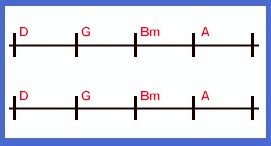Scroll through the lesson and click on notation/video/audio links to load the interactive players.
Please subscribe to get full access to all lessons for only $7.95/month PLUS 1 week free trial.

Riff Interactive lessons are
LESS expensive and
MORE interactive than alternatives!
More Info
|
|

In The Style of The Edge (U2) - part 4 Lesson Sample
Lyle: In this lesson you'll learn a few chord
variations from a simple 4 chord
progression. Let's start by looking at a chord
chart:
chord
chart

Lyle: You'll explore several ways to play them
over the neck just like The Edge does. Here's the first
example:
Lyle:
This example is in the basic form or chord shapes that you might
know. Try playing them along to this jam
track:
Looping
Sound Clip 1
Lyle:
I've made a second jam track that is a little fuller in
sound:
Looping
Sound Clip 2
Lyle:
The Edge likes to arpeggiate the chords. Arpeggiate means to pick one note at a
time from the chord. Watch this video
clip:
ex. 1 -
chords
Lyle:
Pick down, down, down, then up for the last note.
Lyle: For the riff example in this lesson, set
your guitar tone to a fairly clean
sound. Add a little chorus
effect, a little reverb, and a delay set for 410ms with a few
repeats. The Edge loves using this type of sound
with arpeggiated riffs like these.
skud: Is there a particular reason to up pick the last
note?
Lyle: skud, it's a normal way to get your pick
to "come back" and be ready for the next series of notes.
Lyle: Next example shows the same 4 chords in
a different place on the neck:
ex. 2 -
chords
Lyle:
In the next example you'll play the same 3 chords again even higher up the
neck!
ex. 3 -
chords
rockman: Using
the open D string......is that a kind of 'pitch axis' effect,
teach?
Lyle: rockman, yes and
droning.
Lyle: The chords would really be called D - G
over D, Bm over D, A over D. You would see them listed like: Bm/D
which just means a Bm chord with a D as the bass note. Now let's take all of
those chords and add an open high E string to create yet another
droning/suspended sound:
ex. 4 - with open
1st string
Lyle:
The key is to keep it simple, produce a good tone that's not too distorted, use
effects at the right place like in this slower tempo type of song
example.
Lyle: Here's example 5 using chords in the
middle of the neck:
ex. 5 - with open
1st string
larry: What do
you call these intervals with the common bass and common high E? Is there a
notation to indicate them?
Lyle:
Larry, good question. In example 5, the first chord is a
Dadd9, second chord is a
G6/D, third is a
Bmadd4/D, and the 4th chord is a
A/D.
Lyle: Here's the next group of variations at
the high point of the neck like you learned in example 3
earlier:
ex. 6 - with open
1st string 1
Lyle:
The Edge also likes to come up with a riff that can fit and repeat over all the
chords. Here's an example of a Dadd9 chord that
you'll arpeggiate over the jam track:
riff 1
Lyle:
Here's the same riff, only one note will change every other
repeat:
riff 2
Lyle:
If you want, you can improvise or solo over the jam track using a B minor
pentatonic scale.
jim: Why would you say B Minor and not D?
Lyle:
Dmajor pent and B minor pent will work, not B minor. The chords are all in the key of D maj,
B is the relative minor of D.
Lyle: Ok class, time for....the secret riff:
secret riff
Lyle:
It's a Dsus4 to D riff. Edge-olian mode!
larry: In
the video you pick this riff down. Earlier on you said to pick the last note
upwards to begin the return. Any specific reason for the
change?
Lyle: larry, I fought with myself on the pick
direction of the secret riff. I decided to pick all down for a even
and powerful sound.
Lyle:
That’s all for this lesson. If you would like further study on this topic or any
other topic, email me at Lyle@theguitar.net
for info on how you can get your own customized guitar lessons like this using
Riff Interactive technology. Your private lessons can be downloaded to your pc
for anytime, anywhere study. Thanks and see you at the next lesson. - Lyle
|
<< load notation from left
|
|
<< load audio from left
|
<< load audio from left
|